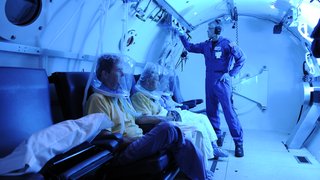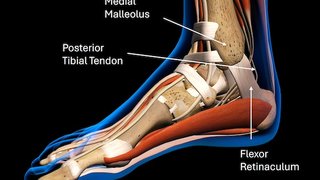Inpatient rehabilitation builds a foundation for lifelong healing
November 6, 2024

After a serious illness or traumatic injury, patients are often at their lowest emotional point. Having to relearn daily tasks such as eating, moving, and even breathing can be a difficult challenge on top of recovering from the primary condition.
Inpatient rehabilitation as part of post-acute care can offer a lifeline, providing a foundation for hope and healing that continues after acute medical care.
UT Southwestern's inpatient Physical Medicine and Rehabilitation (PM&R) team at the Zale Lipshy Pavilion guides patients through the difficult days, weeks, and months after health events such as:
Patients stay in the hospital under the care of our specialized team for a few days to several months, depending on their situation. We handle the basics of daily living so patients can focus on healing and regaining function.
U.S. News and World Report consistently ranks our inpatient rehab program in the top 15 nationally, and in 2023, we cared for 970 patients. In November 2024, we anticipate completion of a renovation of Zale Lipshy Pavilion, where UT Southwestern’s inpatient rehabilitation facilities are located. Upgrades include a remodeled outpatient musculoskeletal gymnasium, an Activities of Daily Living Apartment where patients can practice everyday tasks in a homelike setting, and expanded dialysis treatment capacity, surgical services, and nutrition services spaces to serve more patients and enhance accessibility. Once construction has been completed, inpatient rehabilitation will offer a total of 47 patient beds.
Each patient gets a personalized care plan, based on acute needs and what’s possible with his or her condition and long-term health goals – from hugging grandchildren again to doing laundry, returning to work, or climbing mountains. Every patient gets customized therapy and education to regain independence and reduce their risk of illness, injury, or rehospitalization after they go home.
What to expect in inpatient rehab
Most patients who need inpatient rehabilitation will get a combination of foundational services:
- Physiatrist care, to treat rehabilitation-related medical conditions
- Physical therapy, to regain strength, flexibility, and mobility
- Occupational therapy, to relearn or improve daily living activities, such as dressing, grooming, and school or job skill building
- Speech therapy, to improve communication and swallowing
Along with these services, inpatient rehab offers advanced therapies to support patients’ emotional and lifestyle changes after they transition home:
- Neurologic music therapy, to help improve movement and cognitive skills
- Recreational therapy, to promote physical, emotional, and social well-being
- Wheelchair seating and mobility fitting and device training
- Rehabilitation psychology, to assess and manage the area of neurocognitive function, mood/emotions, and social challenges

Stroke
Every year, more than 795,000 people in the U.S. have a stroke. Lasting impacts depend on how quickly the stroke is treated and which part of the brain is affected. Our inpatient PM&R team can help patients regain function lost due to:
- Muscle weakness or paralysis or stiffness.
- Cognitive problems with memory, attention, or problem-solving.
- Language and communication problems.
- Trouble eating and swallowing.
- Bladder and bowel control.
- Pain.
Most stroke survivors stay in inpatient rehab for 10 to 12 days; severe strokes may require inpatient rehab for eight weeks or more. Stroke rehabilitation may include:
- Rehab psychology: Helps patients cope with emotional changes during recovery.
- Pelvic floor exercises: Strengthening and retraining of the muscles that help control the bowels and bladder.
- Bodyweight supported treadmill: Holds some of patients’ weight to help them practice walking.
- Electrical stimulation: Applies painless energy currents to move the muscles and recover strength.
- Botox injections: To relax tight muscles and reduce stiffness.
- Constraint-induced movement therapy: Encourages use of the affected arm or leg by restricting movement on the unaffected side.
- Mirror therapy: Uses a mirror to make the brain think the affected limb is moving normally, which helps improve movement and coordination.
- Assistive Device for Gait and Orthotics: Helps patients improve gait.

Traumatic brain injury
In 2020, more than 214,000 patients were hospitalized in the U.S. for traumatic brain injuries (TBI) caused by physical trauma or brain disease. Rehab services for TBI depend on what part of the brain is affected and to what extent and are often similar to those for stroke rehabilitation.
TBI can cause emotional and personality changes such as impulsivity and irritability, as well as sensory concerns such as visual disturbances and aversion to noise or touch. Patients who can walk and speak may need inpatient rehab for just a week, whereas patients with TBI resulting in a disorder of consciousness may need to stay six to eight weeks.
UT Southwestern PM&R expert Shanti Pinto, M.D., is conducting advanced research on TBI to improve patient care. Current focus areas include:
- How people with TBI recover over time after inpatient rehab.
- How TBI affects the part of the nervous system that controls automatic functions, such as heart rate and breathing, and how these changes impact recovery.
- Whether adults with post-concussion syndrome can get symptom relief from hyperbaric oxygen therapy – breathing pure oxygen in a pressurized chamber.
Spinal cord injury
Over 250,000 people in the U.S. live with a spinal cord injury (SCI), which damages the bundle of nerves running down the spine and disrupts movement, sensation, and muscle control.

SCI affects each patient differently; while some patients regain sensation and movement over time, others will adapt with lifestyle modifications. Mild to moderate SCI, such as from spinal stenosis or scoliosis, may require inpatient rehab for 10 to 12 days. Severe or traumatic SCI may require three weeks or longer; the higher on the spine the injury, the more therapy is typically needed.
Adapting to a new self-care routine is a major milestone after an SCI. Our PM&R experts help patients develop skills to dress, bathe, and use the toilet as independently as possible. Some patients will need to use catheters to empty their bladder or establish a regular routine and a nutritious diet to avoid constipation or impacted bowels. Patients with SCIs also can get specialized rehab for:
- Breathing issues: Patients learn techniques to strengthen their muscles and optimize lung function.
- Swallowing: Speech therapists guide patients in exercises that support safe swallowing and tone the muscles of the mouth and throat.
- Adaptive fitness: Personalized exercise programs enhance a patient’s physical strength and endurance. The therapists may use our exoskeleton robotic device as part of the patient’s rehabilitation program.
- Emotional support: On-site therapists support patients through lifestyle changes and mental health challenges, such as anxiety, depression, and social isolation.
- Social work support: These experts help patients plan for support at home. We can connect patients with community resources for peer support and daily needs such as transportation.
Patients who need mobility support will get a personalized wheelchair evaluation to find the right device, as well as training in how to customize its settings.
Related reading: How Glen’s journey to getting a power wheelchair got much smoother
Organ transplant
In 2023, UTSW surgeons performed 473 transplants of healthy donor hearts, lungs, kidneys, and livers. After a transplant, patients need inpatient rehab to regain strength and endurance. We offer PM&R support before and after surgery:
- Before: Building strength and range of movement can help reduce the risk of complications and make recovery easier. “Prehabilitation” before an organ transplant can result in better functional outcomes and quality of life.
" 'Prehabilitation' before an organ transplant can result in better functional outcomes and quality of life."
Shelby Halsey, M.D.
- After: Therapy can help patients recover mobility and prevent muscle atrophy (thinning muscle mass) from disuse. Supervised movement can reduce the risk of complications such as bed sores and blood clots.
- In recovery: As the patient regains mobility, therapy can help increase endurance over time. We equip patients with exercises they can continue at home or in an outpatient setting. Inpatient rehab can lead to improved levels of walking ability, balance, overall physical function, and strength after a transplant.
Heart and lung transplant patients often need additional care to strengthen their new organ. We offer cardiovascular prehab to prepare patients for specialized cardiac and pulmonary rehabilitation through our outpatient cardiac rehabilitation clinic or pulmonary rehab services.

Limb loss
Limb loss after trauma, disease, or infection requires big changes to daily routines. Inpatient rehab can help patients manage pain and learn new ways to care for themselves independently:
- Guided movement and massage can help increase blood flow to the affected areas and reduce pain.
- Phantom limb syndrome, a condition where patients can still feel pain in their lost limb, can also be managed with rehab.
- Personalized training helps patients get comfortable with their prosthetics and learn how to use them effectively.
- Adaptive training acclimates patients to new ways to play sports, drive, create art, and more.
Limb loss can be traumatic, with 15% to 26% of patients experiencing post-traumatic stress disorder. Inpatient rehab also supports emotional healing, teaching patients coping mechanisms and connecting them with mental health specialists and social workers. We also work with family members to support their loved one’s recovery, and we provide access to family-centered counseling, support groups, and education during the transition home.
Cancer
Inpatient rehab can help people with any type of cancer manage common side effects of cancer and treatment, including neuropathy, pain, brain fog, and fatigue. Specific types of cancer may require specialized inpatient rehab care:
- Brain cancers: Cognitive therapy addresses memory, attention, and problem solving. Physical therapy improves motor skills and coordination, and speech therapy can help improve speech and swallowing.
- Colorectal cancers: We help patients manage their bowel function, address abdominal pain, and improve mobility. Pelvic floor exercises can help improve incontinence. If patients have an ostomy pouch, we will help them learn how to use and maintain it.
- Esophageal cancers: Speech therapists provide guided exercises to improve swallowing and communication.
- Blood cancers: We help patients with blood cancers like leukemia manage their fatigue through exercise and energy conservation strategies.

Burn injuries
Almost 30,000 burn survivors are admitted to hospitals in the U.S. each year. Nearly one-third are deep burns that require surgery and rehabilitation, and 4% of burn survivors need mechanical ventilation to breathe.
After treatment of severe burn injuries, which can involve multiple surgeries and skin grafts, patients often develop stiff scar tissue that contracts, causing significant pain and limiting movement. Inpatient PM&R experts provide specialized burn rehab that may include:
- Skin care and scar tissue management to enhance flexibility and movement.
- Serial casting to gradually stretch contracted tissue, improving range of motion.
- Mobility therapy to improve strength and flexibility.
- Pain management through targeted exercises.
Healing from a severe burn requires high calorie intake. After a severe burn injury, a patient’s metabolic rate can double for a year or longer due to increased energy expenditure to regulate body temperature, process oxygen, and rebuild damaged tissues. That means they need to consume at least twice as many calories as before (sometimes more) to maintain baseline health and support healing. So, patients may need enteral feeding (feeding tube) support during recovery to get enough calories.
UTSW PM&R leader and burn rehab expert Karen Kowalske, M.D., is the principal investigator for the North Texas Burn Rehabilitation Model System, a research program network dedicated to improving burn care through clinical trials and data collection.
Who qualifies for inpatient rehab?
To qualify, patients must have a medical need for therapy in two of the major therapeutic fields: physical, occupational, and speech therapy. Patients must be willing and able to participate in at least three hours of therapy a day, five days a week. We typically accept patients 18 and older, with exceptions considered case-by-case.

What happens when patients go home?
Inpatient rehab sets the foundation for continued care at home or in a long-term rehabilitation center. As our patients prepare to leave, we connect them with resources to continue healing, such as:
- Home health: In-home visits from therapists and health care professionals to provide ongoing care and support tailored to your recovery needs.
- Transitional programs: A bridge between inpatient rehab and full independence, providing additional support and therapy as you adjust to life outside the hospital.
- Outpatient programs: Scheduled therapy sessions at a clinic or facility, focusing on continued rehabilitation and progress monitoring.
The goal of inpatient rehab is to jumpstart healing and spark hope. Patients who leave our care take with them resources to transition to the next chapter of life with the skills and tools to lead a healthier, higher-quality life after serious illness or injury.
To discuss inpatient rehabilitation services, call 214-645-8300 or request an appointment online.











